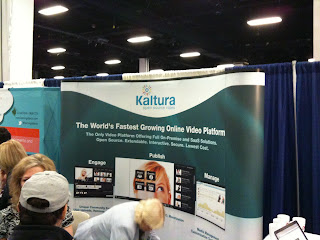On July 26th, a couple of my coworkers and I ventured down to the Campus Technology Conference, held at Boston's Seaport World Trade Center. My job entails working with video, but the majority of my time is spent using projection and audio systems, as well as room control systems. This is the first year I was able to attend the Campus Technology Conference, which is shocking when you consider the fact that it's only a 30 minute subway ride from my office. We only attended the show floor (thanks to Crestron for the free tickets) since we didn't have the time or budget to commit to a few days of breakout sessions/classes. Many of the breakout sessions looked interesting, but the majority of them were really geared toward academic IT departments, and not really academic AV support departments. Since we didn't attend the InfoComm show this year in Orlando, I was interested in seeing some of the new products that were announced at that show.
The first booth we visited was ShareStream, which is a company started by a Harvard alum, David Weinstein. David was in the booth, so the four of us had a nice conversation about the services they provide. To use their words, ShareStream is "a turnkey system for creating, editing, storing, managing, and delivering rich media." In short, it's used to deliver lecture video to students. We work closely with our IT department for storing and delivering lecture video, so this is an area that we're interested in. We're mainly responsible for the acquisition and editing of lecture and event video on campus, then the IT folks store and deliver it via streaming servers. There's more to it, but that's a simplified version of our workflow. So naturally ShareStream provides services that we were interested in hearing about.
We wandered in and out of various booths, but our next big stop was a visit with our friends at the Crestron booth. We use many Crestron room control products on campus, so we're familiar with most of their offerings. We were especially interested in discussing the new products they announced at the InfoComm Show in June. The Crestron rep was pretty excited to tell us about their new Capture-HD system, which is used to capture and encode lecture video. There are quite a few lecture capture systems on the market these days, so it will be interesting to get our hands on a demo unit and try Crestron's solution. Crestron is making a big push for its DigitalMedia system that, in a nutshell, delivers video and audio signals around a room to multiple displays via CAT5 cable with Crestron switchers and signal processing equipment. They're more than just room control systems these days.
Our next stop was at the Kaltura booth. Kaltura is an online video platform that allows users to manager their online video content. It's very flexible (open source) and seems to have a great staff working behind the scenes in support. We had a nice conversation with one of the reps.
Wandering down the show floor aisle we came across another one of our good friends, Extron. In addition to Crestron control systems on campus, we have many, many rooms using Extron control systems. The first item I noticed in the Extron booth was a H.264 encoder that they introduced at InfoComm. It has multiple inputs and seems like a simple solution for H.264 encoding. We spent the rest of our time talking to the Extron reps about the new DVS 605 switcher. This is a new seamless switching scaler that they introduced at InfoComm. The key is that the switcher is DHCP compliant. The exchange of DHCP keys between video sources, switchers/other processors in the signal flow, and ultimately the display can really slow down switching between sources. When we're switching sources in a presentation setting, it needs to be seamless and fast, otherwise it looks very clunky and unprofessional. It'll be very nice to get our hands on a demo unit of the DVS 605.
Next up was a presentation by the Wowza Media Systems CEO, David Stubenvoll. David's talk was about implementing video stream, but of course he peppered it with information about the Wowza Media Server. Wowza can take H.264 content and deliver it to almost any device that can playback video, in many different formats. Flash, Silverlight, Apple HTTP, etc. Davis really knows his stuff about viodeo streaming, and Wowza looks like a great product. We later visited the Wowza booth, and this seems like another company that has a great support staff standing behind the product.
 |
| WolfVision VZ-9plus document camera |
We visited many booths as we made our way down the aisles, but our last big stop was the WolfVision booth. As far as document cameras go, WolfVision makes some exceptional products. If you're not familiar with document cameras, think about the old overhead projectors, just with a camera pointing down at the material, and a VGA or DVI output that can be connected to a projector. We have a few of their VZ-9plus document cameras already on campus, and I also use their EYE-12 camera to project live science demonstrations in the classroom on the projector. WolfVision makes great products. It's amazing how detailed the image is when you have the high res camera zoomed in all the way. You can see details on a dollar bill that you can't see with the naked eye. Great for the art department or some of our professors that use rare books in their teaching.
Even though the Campus Technology Conference is much smaller than the InfoComm show or NAB, they still offered a nice mix of exhibitors. I can't speak to the quality of the breakout sessions/classes, since we didn't take any. Maybe next year we'll have the time and budget to give them a try.





No comments:
Post a Comment